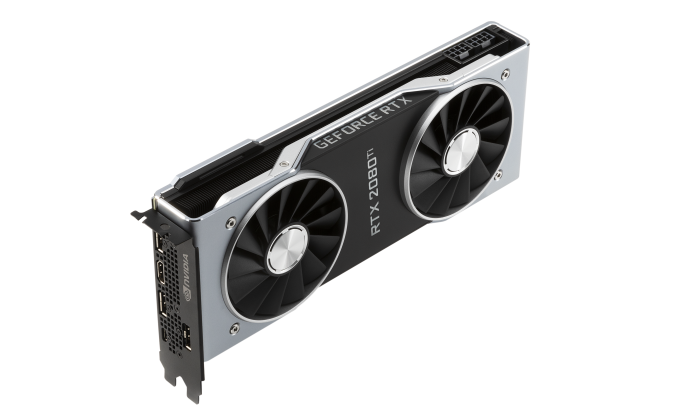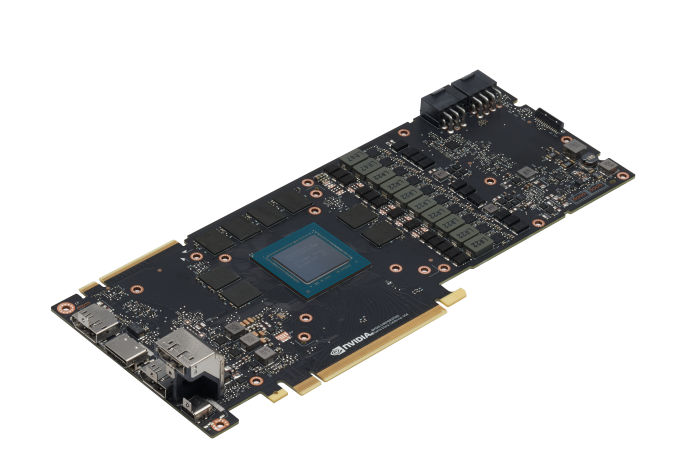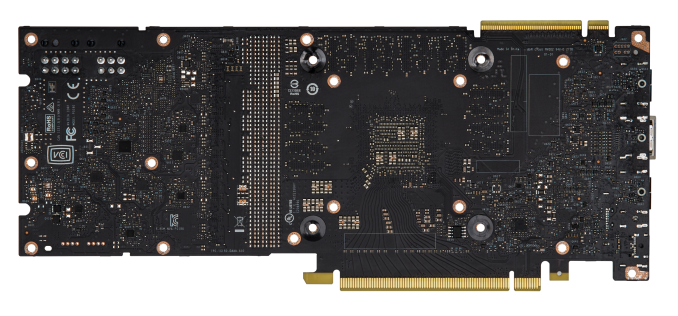The NVIDIA GeForce RTX 2080 Ti & RTX 2080 Founders Edition Review: Foundations For A Ray Traced Future
by Nate Oh on September 19, 2018 5:15 PM EST- Posted in
- GPUs
- Raytrace
- GeForce
- NVIDIA
- DirectX Raytracing
- Turing
- GeForce RTX
Meet The GeForce RTX 2080 Ti & RTX 2080 Founders Editions Cards
Moving onto the design of the cards, we've already mentioned the biggest change: a new open air cooler design. Along with the Founders Edition specification changes, the cards might be considered 'reference' in that they remain a first-party video card sold direct by NVIDIA, but strictly-speaking they are not because they no longer carry reference specifications.
Otherwise, NVIDIA's industrial design language prevails, and the RTX cards bring a sleek flattened aesthetic over the polygonal shroud of the 10 series. The silver shroud now encapsulates an integrated backplate, and in keeping with the presentation, the NVLink SLI connectors have a removable cover.
Internally, the dual 13-blade fans accompany a full-length vapor chamber and component baseplate, connected to a dual-slot aluminum finstack. Looking at improving efficiency and granular power control, the 260W RTX 2080 Ti Founders Edition features a 13-phase iMON DrMOS power subsystem with a dedicated 3-phase system for the 14 Gbps GDDR6, while the 225W RTX 2080 Founders Edition weighing in with 8-phases main and 2-phases memory.
As is typical with higher quality designs, NVIDIA is pushing overclocking, and for one that means a dual 8-pin PCIe power configuration for the 2080 Ti; on paper, this puts the maximum draw at 375W, though specifications-wise the TDP of the 2080 Ti Founders Edition against the 1080 Ti Founders Edition is only 10W higher. The RTX 2080 Founders Edition has the more drastic jump, however, with 8+6 pins and a 45W increase over the 1080's lone 8 pin and 180W TDP. Ultimately, it's a steady increase from the power-sipping GTX 980's 165W.
One of the more understated changes comes with the display outputs, which thanks to Turing's new display controller now features DisplayPort 1.4 and DSC support, the latter of which is part of the DP1.4 spec. The eye-catching addition is the VR-centric USB-C VirtualLink port, which also carries an associated 30W not included in the overall TDP.
Something to note is that this change in reference design, combined with the seemingly inherent low-volume nature of the Turing GPUs, cuts into an often overlooked but highly important aspect of GPU sales: big OEMs in the desktop and mobile space. Boutique system integrators will happily incorporate the pricier higher-end parts but from the OEM’s perspective, the GeForce RTX cards are not just priced into a new range beyond existing ones but also bringing higher TDPs and no longer equipped with blower-style coolers in its ‘reference’ implementation.
Given that OEMs often rely on the video card being fully self-exhausting because of a blower, it would certainly preclude a lot of drop-in replacements or upgrades – at least not without further testing. It would be hard to slot into the standard OEM product cycle at the necessary prices, not to mention the added difficulty in marketing. In that respect, there is definitely more to the GeForce RTX 20 series story, and it’s somewhat hard to see OEMs offering GeForce RTX cards. Or even the RT Cores themselves existing below the RTX 2070, just on basis of the raw performance needed for real time ray tracing effects at reasonable resolutions and playable framerates. So it will be very interesting to see how the rest of NVIDIA’s product stack unfolds.
















337 Comments
View All Comments
imaheadcase - Wednesday, September 19, 2018 - link
They wouldn't, because they would not have the extra bloat in the card, but performed the exact same..people would get the AMD card because of all the bullshit in the nvidia card not yet even proven to by worth it.Better question: How much does nvidia pay you to be a shill here and on forums? I mean you are obviously delusional about it.
DigitalFreak - Wednesday, September 19, 2018 - link
Typical fanboy response.Fritzkier - Wednesday, September 19, 2018 - link
Do you actually read V900's other comments? He is a shill.And anyway AMD did the same thing with Vega 64 (1080 ish performance but a little expensive, except in Vulkan) and see that many also outrageous with Vega releases. That's just because AMD is one year late and making it a little expensive.
bji - Wednesday, September 19, 2018 - link
He may not be a shill; perhaps he's just trying to counterbalance the clueless posters who don't understand why products cost what they do.I know that I am not a shill for anyone, but I can understand the motivation in posting something like that.
tamalero - Wednesday, September 19, 2018 - link
Cost means nothing if they cant provide what they are expected to.Noone gives a darn if the die is insane if their performance isnt as good as promised.
R600 was huge, hot, and was a total new game in graphic design and tech. Was its performance good? NO.
Inteli - Wednesday, September 19, 2018 - link
I think they're substantially overblowing the significance of raytracing and DLSS, at least in this generation's lifespan.The best way I've seen it put is this: look at the Shadow of the Tomb Raider demo. There isn't *that* much of a difference between raytracing on and off. Shaders, ambient occlusion, and other such cheats have gotten so good that they're very close to ray tracing.
Will ray tracing ever be significantly better than raster rendering? Of course it will. It's the future of rendering. Is it significantly better now? No.
It's not an issue of "card is expensive", it "card isn't a good value compared to its predecessors in current games". Most of those extra transistors aren't contributing to the card's performance right now, so you're paying a lot more for nothing, at least right now. For current games, the 2080 is 1080 Ti performance for 1080 Ti prices.
Unless you either A. must have the latest and greatest, or B. anticipate playing games that have been confirmed to support RT, I don't see a compelling reason to buy a 2080 over a 1080 Ti, at least until 1080 Ti supply dries up.
BurntMyBacon - Thursday, September 20, 2018 - link
@Inteli: "For current games, the 2080 is 1080 Ti performance for 1080 Ti prices."I think you meant greater than 1080Ti prices. At the same price and performance, I'd buy newer if for no other reason than to have longer support. The extra features (regardless of whether or not they are used in games I play) are just icing on the cake at that point.
Inteli - Saturday, September 22, 2018 - link
Right.eva02langley - Thursday, September 20, 2018 - link
Because it is their only selling point. It is obviously not the performances.imaheadcase - Wednesday, September 19, 2018 - link
OH so my 1080Ti makes me a AMD fanboy. right..